The Yellow Submarine Chronicles Part Six: There’s Only One Way to Go Out
On Wednesday July 17, 1968, the film Yellow Submarine premiered at the Pavilion 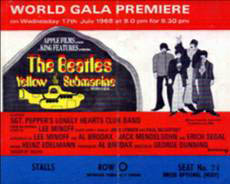 Theater in London’s Piccadilly Circus, the same venue where A Hard Day’s Night and Help had made their debuts a few years earlier. Reporters who covered the event described it as the last great public demonstration of Beatlemania. It had been a long hard year for the production team assembled to create this nightmare turned masterpiece but as their hard work blazed across the giant movie screen they knew they had, at the very least, made animation history.
Theater in London’s Piccadilly Circus, the same venue where A Hard Day’s Night and Help had made their debuts a few years earlier. Reporters who covered the event described it as the last great public demonstration of Beatlemania. It had been a long hard year for the production team assembled to create this nightmare turned masterpiece but as their hard work blazed across the giant movie screen they knew they had, at the very least, made animation history.
In a show of support that was becoming rarer at this point in their collective career, John, Paul, George, and Ringo turned out for the premier accompanied by their respective spouses and girlfriends (including Yoko Ono in one of her earliest public appearances with John Lennon). As they dashed from their cars into the theater, worried policemen strained to hold back the tide of fans that threatened to burst out at any moment. Aside from the fashions being different and the Beatles appearing to have aged more than the few short years it had really been, this could have easily passed for an event in 1964 when they were at the top of their popularity.
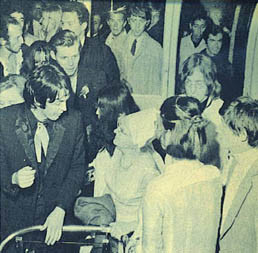 Joining the Beatles on this hip night of promotion was a virtual who’s who of the rock and roll elite, including members of The Rolling Stones, The Bee Gees, and almost every artist signed to the Beatles’ new Apple recording label. Many of the animators and production personnel were also on hand to see the finished product of their labor and the public’s reaction to it. The film’s British distributor, the Rank Organization, tried to downplay the fact that the Beatles did not provide their own voices for the film and attempted to omit the actors who portrayed them from the guest list. A phone call to the company from an angry John Clive (the voice of the animated John Lennon), offering to go to the newspaper with the story the following day if the voice actors were not admitted to the screening, rectified the situation. In the end though, they were surprised to see that their on screen credits listed them only as “Voices”.
Joining the Beatles on this hip night of promotion was a virtual who’s who of the rock and roll elite, including members of The Rolling Stones, The Bee Gees, and almost every artist signed to the Beatles’ new Apple recording label. Many of the animators and production personnel were also on hand to see the finished product of their labor and the public’s reaction to it. The film’s British distributor, the Rank Organization, tried to downplay the fact that the Beatles did not provide their own voices for the film and attempted to omit the actors who portrayed them from the guest list. A phone call to the company from an angry John Clive (the voice of the animated John Lennon), offering to go to the newspaper with the story the following day if the voice actors were not admitted to the screening, rectified the situation. In the end though, they were surprised to see that their on screen credits listed them only as “Voices”.
 The premier of Yellow Submarine was a rousing success and the film continued to play to capacity crowds for the remainder of this limited engagement. In an odd business move that has never been adequately explained, the Rank Organization decided not to give the film a full general release in England. When pressed for a reason, the company stated that a follow up screening in theaters outside of London had not yielded the returns expected and, as a result, they eliminated bookings from approximately two thirds of their theaters. The exact figures for this second set of screenings has never surfaced and the financial wisdom of limiting the availability of a $1.5 million dollar feature film showcasing one of the hottest musical groups on the planet at that time has never been commented on any further by the company.
The premier of Yellow Submarine was a rousing success and the film continued to play to capacity crowds for the remainder of this limited engagement. In an odd business move that has never been adequately explained, the Rank Organization decided not to give the film a full general release in England. When pressed for a reason, the company stated that a follow up screening in theaters outside of London had not yielded the returns expected and, as a result, they eliminated bookings from approximately two thirds of their theaters. The exact figures for this second set of screenings has never surfaced and the financial wisdom of limiting the availability of a $1.5 million dollar feature film showcasing one of the hottest musical groups on the planet at that time has never been commented on any further by the company.
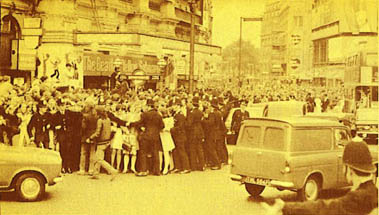 Part of the Rank Organization’s release strategy may have been influenced by the reviews of English critics, who were generally negative towards the film. In the year that had elapsed while the animated film was being created, the Beatles had lost their manager (Brian Epstein died of an accidental overdose in August of 1967), founded their own production company (Apple), and made their own television movie that no one could figure out, Magical Mystery Tour. The failure of this latter venture was viewed by many critics as the sign that the Beatles’ star had finally begun to dim and they wasted no time in trying to tear apart any new product that had their name on it. The Beatles had also become more reclusive as a result of the recent events, their interest in Eastern studies, and the demands of running their own company, and this did not sit well with many of their fans. Growing pains for the group and the public’s changing perception of their beloved mop tops may have torpedoed the Submarine in England but it wasn’t sunk yet.
Part of the Rank Organization’s release strategy may have been influenced by the reviews of English critics, who were generally negative towards the film. In the year that had elapsed while the animated film was being created, the Beatles had lost their manager (Brian Epstein died of an accidental overdose in August of 1967), founded their own production company (Apple), and made their own television movie that no one could figure out, Magical Mystery Tour. The failure of this latter venture was viewed by many critics as the sign that the Beatles’ star had finally begun to dim and they wasted no time in trying to tear apart any new product that had their name on it. The Beatles had also become more reclusive as a result of the recent events, their interest in Eastern studies, and the demands of running their own company, and this did not sit well with many of their fans. Growing pains for the group and the public’s changing perception of their beloved mop tops may have torpedoed the Submarine in England but it wasn’t sunk yet.
The seas of the British movie theaters were rough ones for Yellow Submarine but American audiences embraced it with open arms when it was released stateside four months later on November 13. United Artists distributed the film themselves in the United States (probably learning from the mistake they had made in England) and the modestly budgeted feature pulled in millions during its initial release. American critics were also much kinder and, while there were a few unfavorable opinions aimed mainly at the film’s nebulous target audience, it was praised by the majority as a breakthrough in animation style and technique.
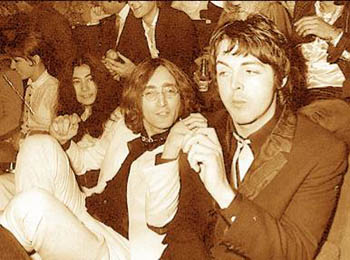 Following the premier in England and the subsequent release throughout the rest of the country, one of the strangest controversies surrounding the film occurred. In the original version of the film, after rallying the people of Pepperland to revolt against the Blue Meanies, the Beatles discover the trapped Sergeant Pepper and his Lonely Hearts Club Band and set them free. As the two groups are trading introductions, they are attacked by a group of Meanies and their multi-headed dogs, which serves as a set up for the song Hey Bulldog. For some reason, this segment of the film was excised some time in August and a brief bridging sequence was put in its place (featuring a few bars of Baby You’re a Rich Man). Without this scene, the fact that the Beatles really are dead ringers for Pepper’s band (except that his John and George don’t have facial hair) is understated and the film is deprived of its best original tune. Theories on why this happened vary widely (some site critical complaints that the film was too long or had too many endings), but the common belief is that Apple feared poor soundtrack sales based on the perceived box office returns and decided to make the public pay for the album if they wanted to hear all of the new songs. While this theory seems plausible, Apple must have really felt Bulldog was the hands down winner of the batch to pull a sequence so important to the plot when Only a Northern Song could have easily been removed without being missed.
Following the premier in England and the subsequent release throughout the rest of the country, one of the strangest controversies surrounding the film occurred. In the original version of the film, after rallying the people of Pepperland to revolt against the Blue Meanies, the Beatles discover the trapped Sergeant Pepper and his Lonely Hearts Club Band and set them free. As the two groups are trading introductions, they are attacked by a group of Meanies and their multi-headed dogs, which serves as a set up for the song Hey Bulldog. For some reason, this segment of the film was excised some time in August and a brief bridging sequence was put in its place (featuring a few bars of Baby You’re a Rich Man). Without this scene, the fact that the Beatles really are dead ringers for Pepper’s band (except that his John and George don’t have facial hair) is understated and the film is deprived of its best original tune. Theories on why this happened vary widely (some site critical complaints that the film was too long or had too many endings), but the common belief is that Apple feared poor soundtrack sales based on the perceived box office returns and decided to make the public pay for the album if they wanted to hear all of the new songs. While this theory seems plausible, Apple must have really felt Bulldog was the hands down winner of the batch to pull a sequence so important to the plot when Only a Northern Song could have easily been removed without being missed.
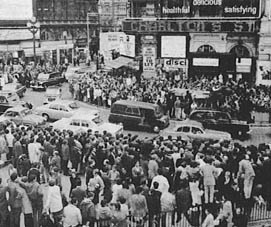 Thankfully, the release of the film in the US and much of the rest of the world outside England made it a box office success but there was never any serious talk of a sequel (not counting John Lennon announcing at the premier that he would write the screenplay for the Beatles’ next animated adventure!). Ironically, the film that was approved by the Beatles primarily to fulfill their contractual obligations to United Artists, failed to do so when the studio realized the contract called for the Fab Four to star in the film! Providing songs and a brief appearance at the end was not enough to satisfy these terms and this eventually forced the creation of the group’s final film, the somber documentary Let It Be. By 1968, the Beatles were beginning to drift apart to pursue individual interests and relationships. The writing on the wall for the end of the group was becoming more apparent but they still managed to give their fans a great new way to enjoy their music and added another facet to their legend. The theatrical release would not be the end of the voyage for this Submarine though and the final chapter of The Yellow Submarine Chronicles will look at the film’s life after the 60’s.
Thankfully, the release of the film in the US and much of the rest of the world outside England made it a box office success but there was never any serious talk of a sequel (not counting John Lennon announcing at the premier that he would write the screenplay for the Beatles’ next animated adventure!). Ironically, the film that was approved by the Beatles primarily to fulfill their contractual obligations to United Artists, failed to do so when the studio realized the contract called for the Fab Four to star in the film! Providing songs and a brief appearance at the end was not enough to satisfy these terms and this eventually forced the creation of the group’s final film, the somber documentary Let It Be. By 1968, the Beatles were beginning to drift apart to pursue individual interests and relationships. The writing on the wall for the end of the group was becoming more apparent but they still managed to give their fans a great new way to enjoy their music and added another facet to their legend. The theatrical release would not be the end of the voyage for this Submarine though and the final chapter of The Yellow Submarine Chronicles will look at the film’s life after the 60’s.
